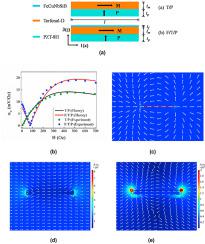当前位置:
X-MOL 学术
›
Mech. Mater.
›
论文详情
Our official English website, www.x-mol.net, welcomes your
feedback! (Note: you will need to create a separate account there.)
Theoretical study on self-biased magnetoelectric effect of layered magnetoelectric composites
Mechanics of Materials ( IF 3.4 ) Pub Date : 2020-12-01 , DOI: 10.1016/j.mechmat.2020.103609 Juanjuan Zhang , Han Du , Xiaodong Xia , Chao Fang , George J. Weng
Mechanics of Materials ( IF 3.4 ) Pub Date : 2020-12-01 , DOI: 10.1016/j.mechmat.2020.103609 Juanjuan Zhang , Han Du , Xiaodong Xia , Chao Fang , George J. Weng

|
Abstract By introducing a high permeability material into the traditional magnetoelectric (ME) composite, a non-zero ME coefficient can be obtained when the external DC magnetic field is zero. This is called the self-biased ME effect. In this system, the high permeability material can be regarded as a special ferromagnetic material. A magnetic field will be generated around it, which affects the internal magnetic field distribution of the ferromagnetic phase in the ME composite. In this paper, we consider the multi-field coupling characteristics of the ME composites, the non-linear characteristics of the individual component materials, and the mechanical and magnetic properties of the high permeability material, to develop a theoretical model for such self-biased ME effect. Then the finite element method is employed to solve the Maxwell equations for this complex problem. The developed theory is highlighted with a direct comparison with experiments that shows their close agreement. It is also demonstrated that, with the addition of the high permeability material, the self-biased ME coefficient can account for 47% of the maximum ME coefficient. This remarkable outcome, and the detailed distributions of the magnetic field, electric field, and elastic field inside ME structures are also presented in detail. Finally, the influence of temperature on the ME effect of the two structures was also studied, and the results showed that the higher the temperature, the smaller the ME coefficient of the structures.
中文翻译:

层状磁电复合材料自偏磁电效应的理论研究
摘要 通过在传统的磁电(ME)复合材料中引入高导磁率材料,可以在外部直流磁场为零时获得非零的磁电系数。这称为自偏 ME 效应。在该系统中,高磁导率材料可视为一种特殊的铁磁材料。其周围会产生磁场,影响ME复合材料中铁磁相的内部磁场分布。在本文中,我们考虑了 ME 复合材料的多场耦合特性、单个组件材料的非线性特性以及高磁导率材料的机械和磁性能,以开发这种自偏置的理论模型。我的效果。然后采用有限元方法求解这个复杂问题的麦克斯韦方程组。通过与实验的直接比较来突出发展的理论,表明它们非常一致。还证明了添加高磁导率材料后,自偏置ME系数可以占到最大ME系数的47%。还详细介绍了这一显着的结果,以及 ME 结构内磁场、电场和弹性场的详细分布。最后,还研究了温度对两种结构ME效应的影响,结果表明温度越高,结构的ME系数越小。通过与实验的直接比较来突出发展的理论,表明它们非常一致。还证明了添加高磁导率材料后,自偏置ME系数可以占到最大ME系数的47%。还详细介绍了这一显着的结果,以及 ME 结构内磁场、电场和弹性场的详细分布。最后,还研究了温度对两种结构ME效应的影响,结果表明温度越高,结构的ME系数越小。通过与实验的直接比较来突出发展的理论,表明它们非常一致。还证明了添加高磁导率材料后,自偏置ME系数可以占到最大ME系数的47%。还详细介绍了这一显着的结果,以及 ME 结构内磁场、电场和弹性场的详细分布。最后,还研究了温度对两种结构ME效应的影响,结果表明温度越高,结构的ME系数越小。还详细介绍了ME结构内部的磁场、电场和弹性场的详细分布。最后,还研究了温度对两种结构ME效应的影响,结果表明温度越高,结构的ME系数越小。还详细介绍了ME结构内部的磁场、电场和弹性场的详细分布。最后,还研究了温度对两种结构ME效应的影响,结果表明温度越高,结构的ME系数越小。
更新日期:2020-12-01
中文翻译:

层状磁电复合材料自偏磁电效应的理论研究
摘要 通过在传统的磁电(ME)复合材料中引入高导磁率材料,可以在外部直流磁场为零时获得非零的磁电系数。这称为自偏 ME 效应。在该系统中,高磁导率材料可视为一种特殊的铁磁材料。其周围会产生磁场,影响ME复合材料中铁磁相的内部磁场分布。在本文中,我们考虑了 ME 复合材料的多场耦合特性、单个组件材料的非线性特性以及高磁导率材料的机械和磁性能,以开发这种自偏置的理论模型。我的效果。然后采用有限元方法求解这个复杂问题的麦克斯韦方程组。通过与实验的直接比较来突出发展的理论,表明它们非常一致。还证明了添加高磁导率材料后,自偏置ME系数可以占到最大ME系数的47%。还详细介绍了这一显着的结果,以及 ME 结构内磁场、电场和弹性场的详细分布。最后,还研究了温度对两种结构ME效应的影响,结果表明温度越高,结构的ME系数越小。通过与实验的直接比较来突出发展的理论,表明它们非常一致。还证明了添加高磁导率材料后,自偏置ME系数可以占到最大ME系数的47%。还详细介绍了这一显着的结果,以及 ME 结构内磁场、电场和弹性场的详细分布。最后,还研究了温度对两种结构ME效应的影响,结果表明温度越高,结构的ME系数越小。通过与实验的直接比较来突出发展的理论,表明它们非常一致。还证明了添加高磁导率材料后,自偏置ME系数可以占到最大ME系数的47%。还详细介绍了这一显着的结果,以及 ME 结构内磁场、电场和弹性场的详细分布。最后,还研究了温度对两种结构ME效应的影响,结果表明温度越高,结构的ME系数越小。还详细介绍了ME结构内部的磁场、电场和弹性场的详细分布。最后,还研究了温度对两种结构ME效应的影响,结果表明温度越高,结构的ME系数越小。还详细介绍了ME结构内部的磁场、电场和弹性场的详细分布。最后,还研究了温度对两种结构ME效应的影响,结果表明温度越高,结构的ME系数越小。











































 京公网安备 11010802027423号
京公网安备 11010802027423号